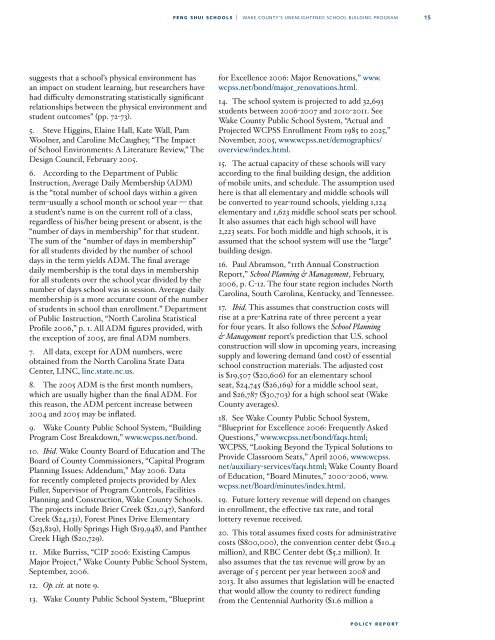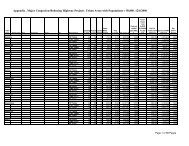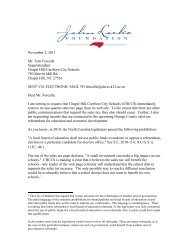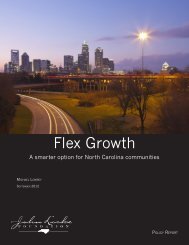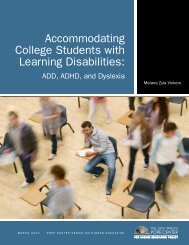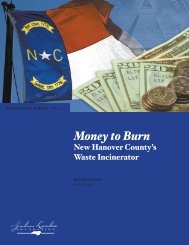Feng Shui Schools - John Locke Foundation
Feng Shui Schools - John Locke Foundation
Feng Shui Schools - John Locke Foundation
Create successful ePaper yourself
Turn your PDF publications into a flip-book with our unique Google optimized e-Paper software.
f e n g s h u i s c h o o l s |<br />
wake County’s unenlightened school building program<br />
15<br />
suggests that a school’s physical environment has<br />
an impact on student learning, but researchers have<br />
had difficulty demonstrating statistically significant<br />
relationships between the physical environment and<br />
student outcomes” (pp. 72-73).<br />
5. Steve Higgins, Elaine Hall, Kate Wall, Pam<br />
Woolner, and Caroline McCaughey, “The Impact<br />
of School Environments: A Literature Review,” The<br />
Design Council, February 2005.<br />
6. According to the Department of Public<br />
Instruction, Average Daily Membership (ADM)<br />
is the “total number of school days within a given<br />
term–usually a school month or school year — that<br />
a student’s name is on the current roll of a class,<br />
regardless of his/her being present or absent, is the<br />
“number of days in membership” for that student.<br />
The sum of the “number of days in membership”<br />
for all students divided by the number of school<br />
days in the term yields ADM. The final average<br />
daily membership is the total days in membership<br />
for all students over the school year divided by the<br />
number of days school was in session. Average daily<br />
membership is a more accurate count of the number<br />
of students in school than enrollment.” Department<br />
of Public Instruction, “North Carolina Statistical<br />
Profile 2006,” p. 1. All ADM figures provided, with<br />
the exception of 2005, are final ADM numbers.<br />
7. All data, except for ADM numbers, were<br />
obtained from the North Carolina State Data<br />
Center, LINC, linc.state.nc.us.<br />
8. The 2005 ADM is the first month numbers,<br />
which are usually higher than the final ADM. For<br />
this reason, the ADM percent increase between<br />
2004 and 2005 may be inflated.<br />
9. Wake County Public School System, “Building<br />
Program Cost Breakdown,” www.wcpss.net/bond.<br />
10. Ibid. Wake County Board of Education and The<br />
Board of County Commissioners, “Capital Program<br />
Planning Issues: Addendum,” May 2006. Data<br />
for recently completed projects provided by Alex<br />
Fuller, Supervisor of Program Controls, Facilities<br />
Planning and Construction, Wake County <strong>Schools</strong>.<br />
The projects include Brier Creek ($21,047), Sanford<br />
Creek ($24,131), Forest Pines Drive Elementary<br />
($23,829), Holly Springs High ($19,948), and Panther<br />
Creek High ($20,729).<br />
11. Mike Burriss, “CIP 2006: Existing Campus<br />
Major Project,” Wake County Public School System,<br />
September, 2006.<br />
12. Op. cit. at note 9.<br />
13. Wake County Public School System, “Blueprint<br />
for Excellence 2006: Major Renovations,” www.<br />
wcpss.net/bond/major_renovations.html.<br />
14. The school system is projected to add 32,693<br />
students between 2006-2007 and 2010-2011. See<br />
Wake County Public School System, “Actual and<br />
Projected WCPSS Enrollment From 1985 to 2025,”<br />
November, 2005, www.wcpss.net/demographics/<br />
overview/index.html.<br />
15. The actual capacity of these schools will vary<br />
according to the final building design, the addition<br />
of mobile units, and schedule. The assumption used<br />
here is that all elementary and middle schools will<br />
be converted to year-round schools, yielding 1,124<br />
elementary and 1,623 middle school seats per school.<br />
It also assumes that each high school will have<br />
2,223 seats. For both middle and high schools, it is<br />
assumed that the school system will use the “large”<br />
building design.<br />
16. Paul Abramson, “11th Annual Construction<br />
Report,” School Planning & Management, February,<br />
2006, p. C-12. The four state region includes North<br />
Carolina, South Carolina, Kentucky, and Tennessee.<br />
17. Ibid. This assumes that construction costs will<br />
rise at a pre-Katrina rate of three percent a year<br />
for four years. It also follows the School Planning<br />
& Management report’s prediction that U.S. school<br />
construction will slow in upcoming years, increasing<br />
supply and lowering demand (and cost) of essential<br />
school construction materials. The adjusted cost<br />
is $19,507 ($20,606) for an elementary school<br />
seat, $24,745 ($26,169) for a middle school seat,<br />
and $26,787 ($30,703) for a high school seat (Wake<br />
County averages).<br />
18. See Wake County Public School System,<br />
“Blueprint for Excellence 2006: Frequently Asked<br />
Questions,” www.wcpss.net/bond/faqs.html;<br />
WCPSS, “Looking Beyond the Typical Solutions to<br />
Provide Classroom Seats,” April 2006, www.wcpss.<br />
net/auxiliary-services/faqs.html; Wake County Board<br />
of Education, “Board Minutes,” 2000-2006, www.<br />
wcpss.net/Board/minutes/index.html.<br />
19. Future lottery revenue will depend on changes<br />
in enrollment, the effective tax rate, and total<br />
lottery revenue received.<br />
20. This total assumes fixed costs for administrative<br />
costs ($800,000), the convention center debt ($10.4<br />
million), and RBC Center debt ($5.2 million). It<br />
also assumes that the tax revenue will grow by an<br />
average of 5 percent per year between 2008 and<br />
2013. It also assumes that legislation will be enacted<br />
that would allow the county to redirect funding<br />
from the Centennial Authority ($1.6 million a<br />
p o l i c y r e p o r t


